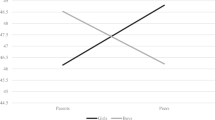Abstract
This study concerns the relationship between friendship variables and adolescent psychosocial development, in particular identity and psychosocial intimacy as envisaged by E. Erikson [(1950), Childhood and Society, New York: Norton; (1968), Identity: Youth and Crisis, New York: Norton]. Two hundred and twenty-three secondary school and college students were surveyed regarding friendship networks, beliefs about friendship, functions of friendship in general, and aspects of a best friendship. Intimacy and identity measures were obtained using the Erikson Psychosocial Stage Inventory [D. Rosenthal, R. Gurney, and S. Moore (1981), “From Trust to Intimacy: A New Measure for Examining Erikson's Stages of Psychosocial Development,” Journal of Youth and Adolescence, Vol. 10, pp. 525–537]. Four developmental style groups (Dual High Scorers, High Identity, High Intimacy, and Dual Low Scorers) were formed from these measures. There were no differences between the sexes in their choice of developmental style. Those in the high-identity-high-intimacy and the high-identity-low-intimacy groups were more satisfied with their friendships, which appeared affectively richer. Sex differences showed that while friendship variables were more strongly associated with development for boys, girls viewed their relationships as closer and ascribed more importance to this closeness.
Similar content being viewed by others
References
Aries, E., & Johnson, F. (1983). Close friendships in adulthood: Conversational content between same sex friends. Sex Roles, 7, 1183–1196.
Berndt, T. (1982). The features and effects of friendship in early adolescence. Child Development, 53, 1447–1460.
Booth, A., & Hess, E. (1974). Cross-sex friendships. Journal of Marriage and the Family, 36, 38–47.
Caldwell, M., & Peplau, L. (1982). Sex differences in same-sex friendship. Sex Roles, 8, 721–732.
Craig-Bray, L., Adams, G. R., & Dobson, W. R. (1988). Identity formation and social relations during late adolescence. Journal of Youth and Adolescence, 17, 173–187.
de Jong-Giervald, J. (1987). Developing and testing a model of loneliness. Journal of Personality and Social Psychology, 53, 119–128.
Erikson, E. (1950). Childhood and society. New York: Norton.
Erikson, E. (1968). Identity: Youth and crisis. New York: Norton.
Erikson, E. (1980). Adolescence. In K. S. Pope (Ed.) On love and loving. San Francisco: Jossey Bass.
Fischer, J. (1981). Transitions in relationship style from adolescence to young adulthood. Journal of Youth and Adolescence, 10, 11–23.
Gilligan, C. (1983). In a different voice: Psychological theory and women's development. Cambridge, MA: Harvard University Press.
Hopkins, L. B. (1982). Assessment of identity status in college women using outer space and inner space interviews. Sex Roles, 8, 557–566.
Kacerguis, M. S., & Adams, G. R. (1980). Erikson stage resolution: The relationship between identity and intimacy. Journal of Youth and Adolescence, 9, 117–126.
Johnson, F., & Aries, D. (1983). The talk of women friends. Women's Studies International Forum, 6, 353–361.
Mitchell, J. (1976). Adolescent intimacy. Adolescence, 11, 275–280.
Orlofsky, J. L., Marcia, J. E., & Lesser, I. M. (1973). Ego identity status and the intimacy versus isolation crisis of adulthood. Journal of Personality and Social Psychology, 27, 211–219.
Powers, E., & Bultena, G. (1975). Sex differences in intimate friendships of old age. Journal of Marriage and the Family, 38, 739–747.
Rosenthal, D., Gurney, R., & Moore, S. (1981). From trust to intimacy: A new measure for examining Erikson's stages of psychosocial development. Journal of Youth and Adolescence, 10, 525–537.
Rosenthal, D., Moore, S., & Taylor, M. (1983). Ethnicity and adjustment: A study of the self-image of Anglo-, Greck-, and Italian-Australian working class adolescents. Journal of Youth and Adolescence, 12, 117–135.
Rubin, Z. (1970). Measurement of romantic love. Journal of Personality and Social Psychology, 16, 265–273.
Sandor, D., & Rosenthal, D. A. (1986). Youths' outlook on love: Is it just a stage or two? Journal of Adolescent Research, 1, 199–212.
SPSS, Inc. (1988). SPSS user's guide (3rd ed.) Chicago, IL: Author.
Sullivan, H. (1953). The interpersonal theory of psychiatry. New York: Norton.
Waterman, A. (1982). Identity development from adolescence to adulthood: An extension of theory and a review of research. Developmental Psychology, 18, 341–358.
Wheeler, L., & Nezlek, J. (1977). Sex differences in social participation. Journal of Personality and Social Psychology, 35, 742–754.
White, R. (1972). Intimacy, love and sex. In R. W. White (Ed.) The enterprise of living. New York: Holt, Rinchart and Winston.
Williams, R. (1959). Friendship and social values in a suburban community: An exploratory study. Pacific Sociological Review, 2, 3–10.
Author information
Authors and Affiliations
Additional information
This research was supported by a grant from the Research and Development Committee, Melbourne College of Advanced Education (Now Institute of Education, Melbourne University).
Rights and permissions
About this article
Cite this article
Moore, S., Boldero, J. Psychosocial development and friendship functions in adolescence. Sex Roles 25, 521–536 (1991). https://doi.org/10.1007/BF00290061
Issue Date:
DOI: https://doi.org/10.1007/BF00290061




